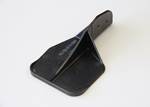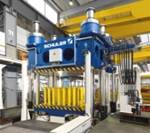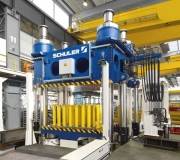Unmanned Aerial System (UAS) Applies Injection Molded Chassis
BlueHalo’s Intense Eye UAS has replaced a machined aerospace-grade aluminum chassis with one molded from Alpine Advanced Materials’ HX5 multi-scale reinforced polymer for a stronger, lighter craft.
The next generation of BlueHalo’s (Arlington, Va.) Intense Eye Unmanned Aerial System (UAS) aircraft features an injection molded chassis using HX5, a multi-scale reinforced polymer from Alpine Advanced Materials (Dallas). In this application, the HX5 material is replacing machined aerospace-grade aluminum, helping make the craft stronger and lighter with increased efficiency and payload capacity. HX5 was originally developed by Lockheed Martin for use in the F-35 fighter jet to provide a nanocomposite material that offered the strength of aluminum but at half the weight. While Alpine declines to reveal the base resin for HX5, it does say that the nanocomposite exceeds the performance of PEEK and Ultem (PEI) and is comparable to Torlon (PAI).
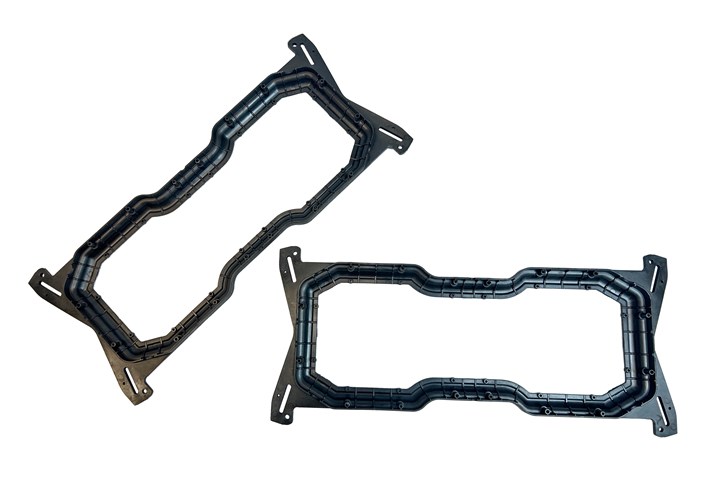
The new injection molded chassis for BlueHalo’s Intense Eye UAS utilizes the HX5 thermoplastic compound from Alpine Advanced Materials for an application that can replace aluminum and weighs just 0.36 lb.
Photo Credit: Alpine Advanced Materials
The Intense Eye UAS family is a 750-mm class 4 rotor Vertical Take Off and Landing (VTOL) UAS for dual-use in commercial and military operations. The system’s software and avionics apply BlueHalo’s artificial intelligence (AI) and machine learning (ML) technologies, giving the craft heightened autonomy and communications, as well as swarm logic capabilities, allowing multiple Intense Eye’s to fly in synchronization with each other.
The chassis, which measures 18.0 by 8.125 by 1.0 in, is molded by Prudent American Technologies at its Lexington, Ky. facility on a 400-ton Nissei press, and weighs only 0.36 lb. BlueHalo collaborated directly with Alpine on the project, utilizing Moldex3D analysis to optimize fiber alignment and strength in critical areas. In addition to the mechanical and environmental benefits of using HX5, BlueHalo says shifting to injection molding will allow it to accelerate production and delivery. It also allowed the craft to consolidate parts on a 7:1 ratio.
In terms of processing, an Alpine spokesperson told Plastics Technology that any molder with experience running high-temperature materials should easily be able to mold with HX5. From a temperature standpoint, mold temps are typically above 300°F, with barrel temperatures near 750°F. Alpine says that HX5 is, on average, about four times less viscous than a filled PEEK material, allowing molders to reduce cycle time and fill pressures, resulting in parts with less warpage out of the tool. Compared to some instances with carbon-filled PEEK, where sprues were required to be much larger, Alpine says HX5 allows for smaller sprues that still achieve completely filled parts.
Noting that HX5 was designed to replace 6061-T6 aluminum, the spokesperson said Alpine is currently developing an overmolding solution using carbon-fiber reinforced plastics in conjunction with HX5 to compete with and exceed the mechanical capabilities of 7000-series aluminum.
The next generation of IE-V3 platforms will be the first BlueHalo UAS to incorporate the HX5 injection molded chassis. BlueHalo can modify the IE-V3 for custom applications, including autonomous swarming solutions; payload development and deployment; test targets; fire and rescue operations; atmospheric profiling; education and research; and more.
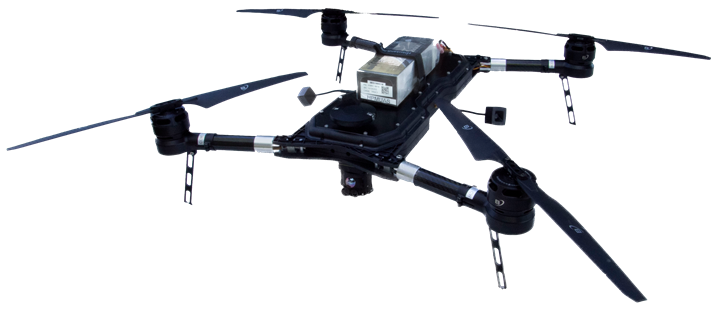
BlueHalo’s Intense Eye is a 750-mm class 4 rotor Vertical Take Off and Landing (VTOL) UAS with commercial and military possibilities.
Photo Credit: Alpine Advanced Materials
Related Content
Know Your Options in Injection Machine Nozzles
Improvements in nozzle design in recent years overcome some of the limitations of previous filter, mixing, and shut-off nozzles.
Read MoreInjection Molding: Focus on these Seven Areas to Set a Preventive Maintenance Schedule
Performing fundamental maintenance inspections frequently assures press longevity and process stability. Here’s a checklist to help you stay on top of seven key systems.
Read MoreHow to Reduce Sinks in Injection Molding
Modifications to the common core pin can be a simple solution, but don’t expect all resins to behave the same. Gas assist is also worth a try.
Read MoreBack to Basics on Mold Venting (Part 2: Shape, Dimensions, Details)
Here’s how to get the most out of your stationary mold vents.
Read MoreRead Next
Carbon Fiber PEEK Replaces Metal in Aircraft Door Fitting
Victrex's 40% carbon fiber-reinforced PEEK results in a 40% savings in both weight and production costs over the incumbent aluminum part.
Read MoreAachen Center, Shuler Form Alliance To Develop Lightweight Automotive, Aerospace Components
Germany's Aachen Center for Integrative Lightweight Production (AZL) will begin manufacturing composite components on a new composite press from Shuler by year's end.
Read More
